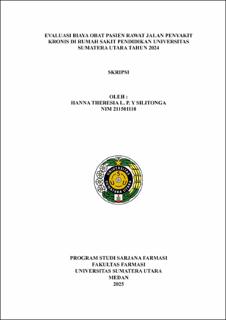| dc.description.abstract | Background: The increasing prevalence of chronic diseases in Indonesia has led to an increase in the need for long-term treatment which has a direct impact on healthcare costs, especially drug costs. Diseases such as diabetes mellitus, hypertension, coronary heart disease, chronic lung disease, and chronic kidney disease occupy a significant position in the national burden of disease and require consistent therapeutic management.
Objective: This study aims to evaluate the relationship between the number of prescribed drugs and drug costs for outpatients with chronic diseases at the Prof. Dr. Chairuddin Panusunan Lubis Education Hospital Medan in 2024.
Methods: This study was a quantitative descriptive study with a cross-sectional approach and used retrospective data from chronic disease outpatient prescriptions during the period January to December 2024. A sample of 370 prescriptions was randomly selected using simple random sampling technique. Data were analyzed using SPSS to determine the relationship between the number of drugs in the prescription and the costs incurred by patients.
Results: The results showed that the majority of patients (57.57%) received prescriptions with between 2-5 types of drugs, with a total cost of Rp 46,727,657. The average drug cost increased with the number of drugs prescribed, where patients who received more than five types of drugs incurred an average cost of IDR246,279. In addition, the polyclinics with the highest drug costs came from patients with chronic lung disease, diabetes mellitus, and coronary heart disease. Statistical analysis showed a positive correlation between the number of drugs and the costs incurred.
Conclusion: This study shows that the higher the number of drugs in one prescription, the higher the drug costs that must be borne by patients. | en_US |


